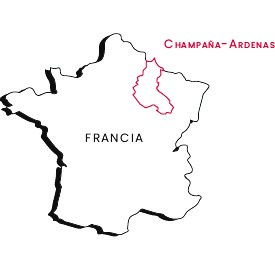If we asked our friends and family about the different types of wine, most would classify them simply as red, white, or rosé. Some might also mention sparkling wines. We often assume that wine color is determined by the type of grape used—red wine from red grapes, white wine from white grapes, and rosé from a mix of both.
However, it’s not that simple. Surprisingly, white wines can be made from black grapes. Paradoxical? Not at all. In this article, we reveal what Blanc de Noirs wine is.
If we translate the term from French, it means “white from blacks”—in other words, a white wine made from black or red grapes.
You might wonder, how is that possible? The explanation is quite simple.
White wine is the only type that can be made from any grape variety. That’s why we have both Blanc de Blancs and Blanc de Noirs wines.
This is because, with a few rare exceptions (such as Alicante Bouschet), all grapes have white pulp. If you squeeze a black grape and separate the skins from the juice, the juice is colorless, meaning it can be used to produce white wine.
In reality, wine color is not determined by the grape’s flesh but by the pigments found in the skins, which contain tannins and polyphenols. The time these skins remain in contact with the juice during maceration and fermentation affects the final color of the wine.
As we will see later, one of the main differences between white and red winemaking is precisely whether or not the grape skins are present during fermentation and maceration.
The name “Blanc de Noirs” already gives us a clue. Its origin can be traced to France, specifically to the Champagne-Ardenne region in the country’s northeast.

Originally, the term referred to the production of sparkling wines, particularly champagne in France and cava in Spain. However, this technique also applies to still wines, like the one we are discussing in this article.
We’ve already given you a hint, but let’s explain it more clearly.
The key to making this special wine lies in the grape’s skin. As mentioned earlier, the pigments responsible for color are found in the skins.
If we want to make red wine, the process is straightforward: use black grapes and allow maceration for a specific period, depending on the style of wine being made. A young red wine, for example, is macerated for a much shorter time than a reserva or gran reserva.
However, if we want to make a white wine from black grapes, we must ensure that the grape skins do not come into contact with the juice. This prevents the pigments from coloring the wine.
From this, we can conclude that there are two ways to make white wine—one simple and the other more complex.
The first is to use white grapes and follow traditional white winemaking methods. Sometimes, white grape juice is macerated with its skins to enhance aromatic potential.
The second option is to use black grapes while carefully avoiding skin contact with the juice. Both methods result in a white wine, but their organoleptic properties will be entirely different. Isn’t that fascinating?
The answer becomes clear once you understand the production process. Blanc de Noirs wines require a more complex winemaking approach and are often made from the best grapes in the vineyard, as they typically undergo barrel aging. The result is an extraordinary wine, full of nuances that differ from those found in traditionally produced wines.
Black grapes tend to have lower acidity than white grapes. As a result, Blanc de Noirs wines have less freshness than traditional white wines, but in return, they offer greater intensity, volume, and aromatic complexity. Their unique character delivers a range of sensations that will leave no one indifferent.
Their flavor also pairs well with a wide variety of dishes, from appetizers and rice dishes to seafood, fish, white meats, and even roasted meats. Did you know that Blanc de Noirs pairs beautifully with chilled melon, a classic summer dessert? There’s no excuse not to try one of these gems on your next vacation, surrounded by your favorite people.
As its name suggests, this is a white wine, but its color is more transparent and less straw-colored than other whites made from Verdejo, Chardonnay, or Sauvignon Blanc. Sometimes, faint reddish hues can be seen when held up to the light.
The most commonly used grape varieties are those with lighter skins, such as Pinot Noir or Pinot Meunier. However, did you know that some wineries also experiment with other varieties like Tempranillo or Tinta Fina?
In terms of flavor, Blanc de Noirs wines tend to be fruity, with notes of red, white, or stone fruits and often a subtle oak influence.
This is a general description, but as with all wines, the range of options is constantly expanding. Blanc de Noirs wines are becoming increasingly recognized and appreciated.
If you haven’t tried one yet, we encourage you to do so. In Spain, only a few wineries have dared to explore this winemaking method, but you can start with the first one made in Ribera del Duero—Pradorey’s Blanc de Noirs, crafted from Tempranillo grapes. Just like its name, El Cuentista, it has a personality of its own—surprising, artisanal, and crafted with exceptional care from one of the finest vineyard plots.
Cheers!
¿Te ha gustado este artículo?